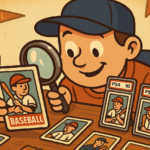Last Updated on October 8, 2024 by Matt Musico
If you’ve ever wondered who the single-season Angels HR leaders are at each position, then you’re in the right place. Outside of pitcher, each player had to man their position for at least 100 games (or 75% of games played) for the season in question.
After you’re done checking this out, head over to the Angels’ all-time and single-season home run leaderboards.
Related: A Complete Guide to Single-Season (& Single-Game) HR Performances
Single-Season Angels HR Leaders
Catcher: Lance Parrish, 1990: 24 Home Runs
Lance Parrish slugged 20-plus homers seven times during his 19-year MLB career. Most of those occurrences happened close together (1980-86). His performance with the California Angels was the last time he reached that plateau.
He slashed .268/.338/.451 to go along with 70 RBI, too. Parrish was elected to his eighth and final All-Star Game and won his sixth and final Silver Slugger Award in 1990. So, it was a last hurrah of sorts before hanging up his spikes following the 1995 season.
Parrish started slowly out of the gates in ’90. He posted a .583 OPS through the end of April before picking it up in May and June. That was the best two-month stretch of his year. Over 191 plate appearances, the backstop slashed .323/.403/.581 with 12 homers and 34 RBI.
Pitcher: Clyde Wright, 1970 & 1972: 2 Home Runs
There’s technically a five-way tie at the top of the Angels’ single-season pitcher home run leaderboard. But since Clyde Wright is the only one to appear twice, we’re giving him the honors.
The 1970 campaign was his best on the mound. He finished sixth in Cy Young voting thanks to a 22-12 record and 2.83 ERA. However, 1972 wasn’t too shabby, either, as his 18 wins and 2.98 ERA were both the second-best single-season marks of his career.
He wasn’t much of a hitter, evidenced by his .478 OPS. But he saved his best work for last in ’72, which was the last time he had a chance to step into the box. Across 93 plate appearances, Wright hit .217/.253/.361 with two homers and 13 RBI.
First Base: Albert Pujols, 2015: 40 Home Runs

Albert Pujols’ Angels tenure wasn’t what anyone hoped it’d be, but the man still racked up the counting stats. His 2015 performance was the seventh and final time he surpassed the 40-homer plateau.
His road OPS (.741) was about 100 points lower than his home OPS (.834), but his power production was nearly identical. He slugged 20 homers with 45 RBI at Angel Stadium and 20 homers with 50 RBI as a visiting player.
May and June were the only two months he produced an OPS higher than .800. His best month — by a longshot — was in June. Pujols slashed .303/.395/.737 with 13 home runs and 26 RBI. The slugger’s homer production was also quite even depending on the game situation. Pujols hit 13 homers with the Angels behind, another 13 with the game tied, and 14 dingers when L.A. had the lead.
Second Base: Bobby Grich, 1979: 30 Home Runs
When we talk about positional home run royalty in Angels history, Bobby Grich is the man at the keystone. He owns the top three most powerful seasons, as well as four of the top five.
During his 17-year career, Grich surpassed 20 homers just twice. This occurrence in 1979 was the first time he accomplished it. That was accompanied by 101 RBI, the only time he reached the century mark. As it turns out when looking at his monthly splits, there was a certain pattern when it came to the second baseman’s power.
Grich slugged six homers in April, eight in June, and seven in August. He didn’t hit more than four in any other month. He also liked stepping to the plate in the fifth inning. During that frame, Grich slashed .386/.476/.714 with six dingers and 18 RBI.
Shortstop: Zach Neto, 2024: 23 Home Runs
While the 2024 season was another lost year for the Angels, it was a record-breaking one for Zach Neto. Jim Fregosi set LA’s single-season shortstop home run record in 1970 with 22 homers. It stood until 2024 when Neto bested him by one dinger.
The Angels selected Neto in the first round of the 2022 MLB Draft out of Campbell University. He debuted in 2023, but the 2024 campaign was his first full big-league season. The 23-year-old posted a .761 OPS with 23 homers, 77 RBI, 70 runs scored, and 30 steals in 155 games.
He racked up at least 20 games in four different lineup spots throughout the year for Los Angeles. His favorite — when using OPS as the barometer — was eighth. Neto slashed .322/.390/.567 in that lineup spot, which resulted in a .957 OPS.
Third Base: Troy Glaus, 2000: 47 Home Runs
Troy Glaus is quite lonely atop the Angels’ single-season home run leaderboard for third basemen. In addition to his 47 homers in 2000, the 41 he hit the following year ranks second in club history. Entering 2023, no other Los Angeles third baseman has slugged more than 30.
Glaus didn’t post a double-digit homer month in 2000, but he got close while staying quite consistent. He never hit fewer than seven dingers, finishing with nine twice (May and September/October). The sweet-swinging right-handed hitter also went buck-wild in the second inning. In 100 plate appearances, Glaus slashed .310/.400/.710 with 11 homers and 17 RBI.
He posted an OPS greater than 1.000 in four other innings but didn’t hit more than six homers during any other frame.
Single-Season Angels HR Leaders
Left Field: Leon Wagner, 1962: 37 Home Runs
When looking at the totality of Leon Wagner’s 12-year MLB career, his 1962 performance was the best one overall. He collected two years of 30 homers and 100 RBI, but the 37 dingers and 107 rib-eye steaks he collected in ’62 were both single-season career-high marks. The outfielder was also selected to two All-Star Games and finished fourth in MVP voting.
His power stroke was much more prevalent on the road, with 24 of his 37 homers coming as a visiting player. Wagner also did the majority of his yard work in the first half. Through his first 361 plate appearances, the outfielder slugged 25 homers and posted a .938 OPS. Over his final 316 trips to the plate, he hit those last 12 homers while watching his OPS drop down to .703.
During the first three months, Wagner never saw his monthly OPS drop below .922. Down the stretch in the final three months, though, he didn’t produce one higher than .778.
Center Field: Mike Trout, 2019: 45 Home Runs

What is any kind of Angels leaderboard without Mike Trout, right? He just had to be here. Entering 2023, Trout owns a career slugging percentage of .587. That number hasn’t finished below .600 in any season since 2017. And, in case you’re wondering, the high-water mark during this period took place in 2019 (.645).
This was his age-27 season, and it finished with him winning his seventh Silver Slugger Award, along with his third AL MVP. That man is pretty good at the baseball thing. If it weren’t for injury, he probably would’ve broken Glaus’ single-season record and gotten to 50. Between March and August, Trout never hit fewer than six homers. This included 13 bombs and 29 RBI while slashing .286/.392/.821 (!) through 102 plate appearances in July. He hit just two homers in September/October because he appeared in only six games (five starts).
It didn’t matter how many outs there were when he stepped to the plate, either — the man was crushing no matter what. With no outs, he owned a 1.095 OPS. That number jumped up to 1.121 with one out and settled in at 1.004 with two outs.
Right Field: Reggie Jackson (1982) & Vladimir Guerrero (2004): 39 Home Runs
After spending five eventful years in the Bronx with the New York Yankees, Reggie Jackson took his talents out west for the final stages of his career. The 1982 season was his first with the Angels, so this was a solid first impression. It was the final 30-plus homer performance of his big-league career, which was accompanied by his 12th All-Star Game selection, his second Silver Slugger, and a sixth-place finish in MVP voting.
Jackson was at his best when the Angels were trailing. If California was staring at any kind of deficit, Reggie hit .308/.394/.637 with 18 homers and 41 RBI.
Like his fellow right fielder, Vladimir Guerrero’s 2004 campaign was his first with the Angels. Instead of finishing sixth in MVP voting, Vlad Sr. ended up taking home MVP honors. Those 39 homers were joined by 126 RBI and a .337/.391/.598 triple slash.
Guerrero was good all year for Los Angeles, but he saved some of his best work for the stretch run. In September/October, the outfielder slashed .363/.424/.726 with 11 homers, six doubles, one triple, and 25 RBI. While he spent all his time in either the third or fourth spots of the lineup, Guerrero led off an inning 131 times. He accumulated 41 total hits, with 19 of them going for extra bases (seven doubles, 12 homers) while posting a 1.070 OPS.
Designated Hitter: Shohei Ohtani, 2021: 46 Home Runs

The 2021 season was the breakout everyone had been waiting for from Shohei Ohtani. Between 2018 and 2020 (967 plate appearances), he slugged 47 homers. In just 639 trips to the plate during an MVP campaign, he virtually doubled it.
Ohtani did most of his work before the All-Star break. He slugged 33 homers with a .698 slugging percentage in 343 first-half plate appearances. That was followed by 13 more dingers and a .458 slugging percentage in 296 trips to the plate following the midsummer classic.
He didn’t slug more than five homers against any opponent in 2021, but he reached that number while facing three teams: the Detroit Tigers, the Seattle Mariners, and the Houston Astros. Oh, yeah — Ohtani also produced a 9-2 record with a 3.18 ERA in 130.1 innings as a pitcher.
If you like what we’re doing here at MLB Daily Dingers, you can support us in several ways. You can check out our apparel shop, grab your official MLB gear at the MLB Shop, join the community by signing up for our email list, or follow us on social media (Twitter, Instagram, Facebook).





Leave a Reply